Dilip Kumar
Mohammed Yusuf Khan[2] (born 11 December 1922),[3] known professionally as Dilip Kumar, is an Indian film actor and philanthropist, best known for his work in Hindi cinema. Referred as "The Tragedy King" and "The First Khan",[3][4] he has been credited for bringing the method acting technique to Indian cinema. Kumar holds the record for most wins for the Filmfare Award for Best Actor and was also the inaugural recipient of the award.[5][6]
Dilip Kumar | |
|---|---|
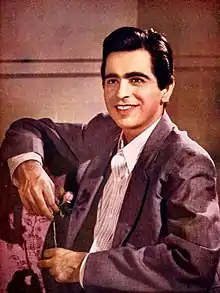 Kumar in 1946 | |
| Born | Mohammed Yusuf Khan 11 December 1922 |
| Citizenship | British Indian (1922–1947) Indian (from 1947) |
| Occupation | Actor, philanthropist |
| Years active | 1944–1998 |
| Spouse(s) | Asma Sahiba
(m. 1981; div. 1983) |
| Awards | Eight Filmfare Awards for Best Actor and Dadasaheb Phalke Award (1994) |
| Honours | Padma Bhushan (1991) Nishan-e-Imtiaz (1998) Padma Vibhushan (2015)[1] |
| Member of Parliament, Rajya Sabha | |
| In office 3 April 2000 – 2 April 2006 | |
| Constituency | Maharashtra |
| Signature | |
 | |
Kumar debuted as an actor in the film Jwar Bhata (1944), produced by Bombay Talkies. In a career spanning over five decades, Kumar worked in over 65 films. Kumar is known for roles in films such as the romantic Andaz (1949), the swashbuckling Aan (1952), the social drama Daag (1952), the dramatic Devdas (1955), the comical Azaad (1955), the epic historical Mughal-e-Azam (1960), the social dacoit crime drama Gunga Jamuna (1961), and the comedy Ram Aur Shyam (1967).
In 1976, Kumar took a five-year break from film performances and returned with a character role in the film Kranti (1981) and continued his career playing leading roles in films such as Shakti (1982), Mashaal (1984), Karma (1986) and Saudagar (1991). His last film was Qila (1998).[7][8]
Dilip Kumar had a long relationship with actress Madhubala but never married her. He married actress Saira Banu in 1966. They currently live in the Bandra suburb of Mumbai in the state of Maharashtra in India. As of 2021, he is one of the last surviving stars from the Golden Age of Hindi cinema.[9]
Early life
Dilip Kumar was born Mohammad Yusuf Khan[10] to Ayesha Begum and Lala Ghulam Sarwar Khan, one of 12 children, on 11 December 1922 at home in the Qissa Khawani Bazaar area of Peshawar, British India. His father was a landlord and fruit merchant who owned orchards in Peshawar and Deolali near Nashik. Mohammad Yusuf Khan was schooled at Barnes School, Deolali, Nashik.[11] He grew up in the same religiously mixed neighbourhood as Raj Kapoor, his childhood friend, and later his colleague in the film industry.[4]
In the latter half of 1940, while still in his teens and after an altercation with his father, Mohammad Yusuf Khan left home for Pune in Maharashtra. With the help of a Parsi café-owner and an elderly Anglo-Indian couple, Kumar met a canteen contractor. Without letting on his family antecedents, he got the job on the merit of his knowledge of good written and spoken English. He set up a sandwich stall at the army club and when the contract ended, he headed home to Bombay, having saved Rs. 5000.[12]
In early 1943, anxious to start a venture to help his father with household finances, he met Dr. Masani at Churchgate Station, who asked him to accompany him to Bombay Talkies, in Malad. There he met actress Devika Rani, owner of Bombay Talkies, who asked him to sign up with the company on a salary of Rs. 1250 per month.[13] He also met actor Ashok Kumar, who influenced his acting style by telling him to act "natural," as well as film producer Sashadhar Mukherjee. Both of these people became close to Kumar over the years. Initially, Kumar helped out in the story-writing and scripting department because of his proficiency in Urdu language. Devika Rani requested him to change his name to Dilip Kumar, and later cast him in a lead role for Jwar Bhata (1944), which marked Kumar's entry into the Hindi film industry.[13]
Career
1940s
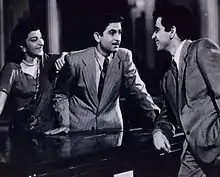
Kumar's first film was Jwar Bhata in 1944, which went unnoticed. After a few more unsuccessful films, it was Jugnu (1947), in which he starred alongside Noor Jehan, that became his first major hit at the box office.[14] His next major hits were the 1948 films Shaheed and Mela. He got his breakthrough role in 1949 with Mehboob Khan's Andaz, in which he starred alongside Raj Kapoor and Nargis. Shabnam also released that year was another box office hit.[14]
1950s

Kumar went on to have success in the 1950s playing leading roles in several box office hits such as Jogan (1950), Babul (1950), Hulchul (1951), Deedar (1951), Tarana (1951), Daag (1952), Sangdil (1952), Shikast (1953), Amar (1954), Uran Khatola (1955), Insaniyat (1955) in which he co-starred with Dev Anand, Devdas (1955), Naya Daur (1957), Yahudi (1958), Madhumati (1958) and Paigham (1959).[15] Some of these films established his screen image as the "Tragedy King".[16] Kumar briefly suffered from depression due to portraying many tragic roles and on the advice of his psychiatrist, he also took on light-hearted roles.[17] Mehboob Khan's big-budget 1952 swashbuckling musical Aan featured him in one of his first lighter roles[18] and marked his first film to be shot in technicolor and to have a wide release across Europe with a lavish premiere in London.[19] He had further success with lighter roles as a thief in the comedy Azaad (1955), and as a royal prince in the romantic musical Kohinoor (1960)[16]
He was the first actor to win the Filmfare Best Actor Award (for Daag) and went on to win it a further seven times.[20][21] He formed popular on-screen pairings with many of the top actresses at the time including Vyjayanthimala, Madhubala, Nargis, Nimmi, Meena Kumari and Kamini Kaushal.[22] 9 of his films in the 1950s were ranked in the Top 30 highest-grossing films of the decade.[23]
In the 1950s, Kumar became the first actor to charge ₹1 lakh (equivalent to ₹85 lakh or US$120,000 in 2019) per film.[24]
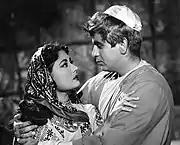
1960s
In 1960, he portrayed Prince Salim in K. Asif's big-budget epic historical film Mughal-e-Azam, which was the highest-grossing film in Indian film history for 11 years until it was surpassed by 1971 film Haathi Mere Saathi and later by the 1975 film Sholay. If adjusted for inflation, Mughal-e-Azam was the highest-grossing Indian film through to the early 2010s, equivalent to over ₹1000 crore in 2011.[25][26]
The film told the story of Prince Salim, who revolts against his father Akbar (played by Prithviraj Kapoor), and falls in love with a courtesan (played by Madhubala). The film was mostly shot in black and white, with only some scenes in the latter half of the film shot in colour. 44 years after its original release, it was fully colourised and re-released in 2004.
In 1961, Kumar produced and starred in Ganga Jamuna opposite his frequent leading lady Vyjayanthimala and his brother Nasir Khan, this was the only film he produced. Kumar chose the shade of saree that Vyjayanthimala would wear in every scene.In 1962 British director David Lean offered him the role of "Sherif Ali" in his film Lawrence of Arabia (1962), but Kumar declined to perform in the movie.[27] The role eventually went to Omar Sharif, the Egyptian actor. Kumar comments in his much later released autobiography, "he thought Omar Sharif had played the role far better than he himself could have".[28] Kumar was also being considered for a leading role opposite Elizabeth Taylor in a film that Lean was working on called Taj Mahal, before the project was cancelled.[29]
His next film Leader (1964) was a below average grosser at the box office.[30] He was the co-director alongside Abdul Rashid Kardar of his next release Dil Diya Dard Liya in 1966, but was uncredited as director. In 1967, Kumar played a dual role of twins separated at birth in the hit film Ram Aur Shyam. In 1968, he starred alongside Manoj Kumar and Waheeda Rehman in Aadmi. That same year he starred in Sunghursh with Vyjayanthimala which was their last film together which created a total of seven hit films together.
1970s
Kumar's career slumped in the 1970s with films like Dastaan (1972) failing at the box office. He starred alongside his real-life wife Saira Banu in Gopi (1970). They were paired again in his first and only Bengali language film Sagina Mahato (1970). A Hindi remake Sagina was made in 1974 with the same cast. He played triple roles as a father and his twin sons in Bairaag (1976) which failed to do well at the box office.[31][32] He personally regarded M. G. Ramachandran's performance in Enga Veetu Pillai better than his role in Ram Aur Shyam. He regards his performance in Bairaag much higher than that of Ram Aur Shyam. Although his performance in Bairaag and Gopi were critically acclaimed, he lost many film offers to act in leading roles to actors Rajesh Khanna and Sanjeev Kumar, from 1968 to 1987. He took a five-year hiatus from films from 1976 to 1981.[33]
1980s
In 1981, he returned to films as a character actor playing central roles in ensemble films. His comeback film was the star-studded Kranti which was the biggest hit of the year.[34] Appearing alongside an ensemble cast including Manoj Kumar, Shashi Kapoor, Hema Malini and Shatrughan Sinha, he played the title role as a revolutionary fighting for India's independence from British rule.[35] He then successfully collaborated with director Subhash Ghai starting with Vidhaata (1982), in which he starred alongside Sanjay Dutt, Sanjeev Kumar and Shammi Kapoor. Later that year he starred alongside Amitabh Bachchan in Ramesh Sippy's Shakti which was a hit grosser at the box office and won him critical acclaim and his eighth and final Filmfare Award for Best Actor.[36] In 1984, he starred in Yash Chopra's social crime drama Mashaal opposite Anil Kapoor which failed at the box office but his performance was critically acclaimed.[37] He also appeared alongside Rishi Kapoor in Duniya (1984) and Jeetendra in Dharm Adhikari (1986).
His second collaboration with Subhash Ghai came with the 1986 ensemble action film Karma. Karma marked the first film which paired him opposite fellow veteran actress Nutan. Three decades earlier however, they were paired together in an incomplete and unreleased film titled Shikwa.[35][38][39] He acted opposite Nutan again in the 1989 film Kanoon Apna Apna.
1990s
In 1991, Kumar starred alongside fellow veteran actor Raaj Kumar in Saudagar, his third and last film with director Subhash Ghai. This was his second film with Raaj Kumar after 1959's Paigham. Saudagar was Kumar's last box office success.[40] In 1993, he won the Filmfare Lifetime Achievement Award for his contribution to the industry for five decades.
In 1992, producer Sudhakar Bokade announced a film titled Kalinga which would officially mark Kumar's directorial debut after he had allegedly previously ghost directed Ganga Jamuna (1961) and Dil Diya Dard Liya (1967).[41] Kumar was also set to star in the title role with the cast including Raj Babbar, Raj Kiran, Amitoj Mann and Meenakshi Seshadri. After being delayed for several years, Kalinga was eventually left incomplete and shelved.[42][43]
In 1998, Kumar made his last film appearance in the box office flop Qila, where he played dual roles as an evil landowner who is murdered and as his twin brother who tries to solve the mystery of his death.
2000s–present
In 2001, Kumar was set to appear in a film titled Asar – The Impact alongside Ajay Devgan and Priyanka Chopra, which was shelved.[44] His classic films Mughal-e-Azam and Naya Daur were fully colourised and re-released in cinemas in 2004 and 2008 respectively.[45] An unreleased film he had shot and completed in 1990 titled Aag Ka Dariya was set for a theatrical release in 2013 but has not been released to date.[46] He was also set to appear in Subhash Ghai's war film, Mother Land, alongside Amitabh Bachchan and Shah Rukh Khan, but this film was shelved after Khan decided to leave the project.[47]
Personal life
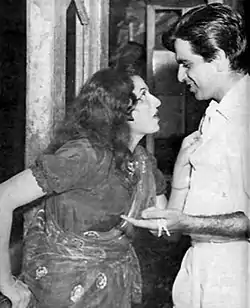
Kumar had fallen in love with Madhubala during the shooting of Tarana. They remained in a relationship for seven years until the Naya Daur court case, during which Kumar testified against Madhubala and her father, ending their relationship.[48] They never worked together again after Mughal-e-Azam (1960).[49] In the late 1950s, Vyjayanthimala was linked by gossip magazines with Kumar, who has acted with her the most compared to any other actress, which resulted in great on-screen chemistry between them. While working for his home production Gunga Jumna (1961), it is said that Kumar handpicked the shade of sari that Vyjayanthimala would wear in every scene. In addition to that, film historians Bunny Reuben and Sanjit Narwekar have "confirmed" the Kumar & Vyjayanthimala's affair where they had said that Vyjayanthimala was Kumar's third love after Kamini Kaushal and Madhubala.
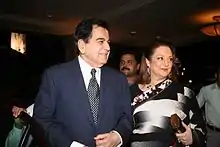
In 1966, Kumar married actress Saira Banu, who was 22 years younger than him. He later married Hyderabad socialite Asma Sahiba, taking her as a second wife in 1981.[50][51] That marriage ended in January 1983.[52] He and his wife Saira Banu currently live in Bandra. Dilip Kumar does not have any children. In his biography "Dilip Kumar: The Substance and the Shadow", he revealed that Saira Banu conceived in 1972, but developed high blood pressure in her eighth month of pregnancy and the doctors couldn't save the baby, which had been strangulated by the umbilical cord. After that, they did not try to have children believing that it was God's will.[53]
He is fluent in Urdu, Hindi, Hindko (his first language), Punjabi, Awadhi, Bhojpuri, Marathi, English, Bengali, Gujarati, Pashto, and Persian.[11][54]
His younger brother Nasir Khan (1924–1974) was also a noted film actor. Two of his younger brothers died during the coronavirus epidemic of 2020 after testing positive for Covid-19 : Aslam Khan died at the age of 88 in August 2020, and Ehsan Khan died at 90 in September 2020. [55]
Dilip Kumar was nominated as a member of the Rajya Sabha, the Upper House of the Parliament of India, by the Indian National Congress for the period 2000–2006 from Maharashtra, according to some sources.[56] But a page hosted by Indian Government for matters about Rajya Sabha does not list his name, and it is not clear whether he was ever a member of Rajya Sabha. [57]
Humanitarian work
- Kumar has been involved with a number of charitable and social initiatives. He planned and conceptualised the famous Jogger's Park in Bandra, along with Sunil Dutt and Oliver Andrade. Kumar used his good offices to get the necessary clearances from the Maharashtra Government for the establishment of this public park.
- Kumar utilized a significant portion of his MPLAD fund towards the construction and improvement of the Bandstand Promenade and the gardens at Bandra Fort at Lands End in Bandra.[58]
Legacy
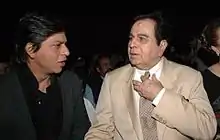
Kumar is widely considered the greatest actor in the history of Hindi cinema.[59][5][6] He holds the Guinness World Record for winning the maximum number of awards by an Indian actor.[60][61] He has received many awards throughout his career, including eight Filmfare Awards for Best Actor and One Lifetime Achievement for Filmfare Also for Special Recognition FilmFare Award for recognising him as one first recipients to receive a Filmfare Award along with the nightingale of India Lata Mangeshkar and one of the greatest Hindi Music Directors Naushad Ali at the 50th Filmfare Award Ceremony and along with 19 nominations at Filmfare for best actor.[62] He was honoured with the Filmfare Lifetime Achievement Award in 1993.[63] Ganga Jamna (1961), which he wrote, produced, and starred in, also received the National Film Award for Second Best Feature Film in Hindi, the Paul Revere Silver Bowl at the Boston International Film Festival, the Special Honour Diploma from the Czechoslovak Academy of Arts in Prague, and the Special Prize at the Karlovy Vary International Film Festival. Actor Shahrukh Khan considers Kumar as his inspiration ever since he began his career as an actor and has often referred Kumar as the main reason for him to pursue a career in acting.
Kumar was appointed Sheriff of Mumbai (an honorary position) in 1980,[63] the Government of India honoured Kumar with the Padma Bhushan in 1991, the Dadasaheb Phalke Award in 1994 and the Padma Vibhushan in 2015. The Government of Andhra Pradesh honoured Kumar with NTR National Award in 1997. The Government of Pakistan conferred Kumar with Nishan-e-Imtiaz, the highest civilian award in Pakistan, in 1998.[64][65][66][67] The ruling political party of Shiv Sena in Maharashtra had objected to this award and questioned Kumar's patriotism. However, in 1999 in consultation with the then Prime Minister of India, Atal Bihari Vajpayee, Kumar retained the award.[68] He was honoured with CNN-IBN Lifetime Achievement Award in 2009.[69]
The Government of India honoured Kumar with:
- 2015 – India's second-highest civilian award, the Padma Vibhushan, for his contributions towards Indian cinema
- 2000–2006 – Elected to Rajya Sabha, the upper house of Indian Parliament.
- 1994 – Dadasaheb Phalke Award
- 1991 – India's third highest civilian award, the Padma Bhushan, for his contributions towards Indian cinema
- 1979–1982 – Appointed as the Sheriff of Bombay by the Governor of Maharashtra, India for the period[70]
- 1998 – Government of Pakistan honoured him with its highest civilian honour, the Nishan-e-Imtiaz (Order of Excellence).[71]
- Till 2000s Kumar was the only actors to have won 8 Filmfare Best Actor Awards until his record was shared by Shahrukh Khan by mid 2000s.
- From the Independence of India to late 2010s Kumar held the record of giving the highest number of box office grossing films(9 films) until his record was broken by Salman Khan by delivering 10 films and his historical movie Mughal-E-Azam was the highest-grossing film (equivalent to 1000 crores in 2015) in Bollywood till 2016 until its record was broken by Aamir Khan's Dangal which collected over 1500 crores at box office.
Autobiography
Dilip Kumar: The Substance and the Shadow as narrated to Udayatara Nayar was published in 2014 by Hay House Publishers (India) Pvt. ltd.[72]
Filmography
References
- "Padma Awards 2015". Press Information Bureau, Government of India. 25 January 2015. Archived from the original on 28 January 2015. Retrieved 26 January 2015.
- "Archived copy". Archived from the original on 15 August 2020. Retrieved 16 August 2020.CS1 maint: archived copy as title (link)
- "Tragedy king Dilip Kumar turns 88". The Indian Express. 11 December 2010. Archived from the original on 11 October 2020. Retrieved 21 June 2012.
- "Happy Birthday Dilip Kumar: As Dilip Kumar turns 94, a look at his titanic reputation as India's finest method actor". Indianexpress.com. 11 December 2016. Retrieved 21 March 2019.
- Sharma, Vishwamitra (2007). Famous Indians of the 21st Century. Pustak Mahal. p. 196. ISBN 978-81-223-0829-7.
- Dawar, Ramesh (2006). Bollywood: yesterday, today, tomorrow. Star Publications. p. 8. ISBN 1-905863-01-2.
- Suresh Kohli (8 January 2004). "Celebrating The Tragedy King". The Hindu. Delhi, India. Retrieved 30 January 2012.
- Coomi Kapoor (8 October 2007). "Personalised fiction, anyone?". The Star (Malaysia). Malaysia. Retrieved 30 January 2012.
- Kumar, Ravi (14 June 2018). "9 Doyens Of Bollywood Who Lived More Than 90 Years". Pycker. Archived from the original on 11 October 2020.
- TNN (1 December 2017), "Dilip Kumar: Interesting chapters of the actor's life" Archived 11 October 2020 at the Wayback Machine, The Times of India. Retrieved 23 June 2018.
- Renuka Vyavahare (28 December 2011). "Here's why Dilip Kumar speaks Marathi fluently!". Articles.timesofindia.indiatimes.com. Retrieved 28 September 2013.
- Kumar, Dilip (2014). The Substance and the Shadow an autobiography (1 ed.). India: Hay House India. p. 102. ISBN 9789381398869. Retrieved 18 October 2015.
- Kumar, Dilip (28 July 2014). Dilip Kumar: The Substance and the Shadow. Hay House, Inc. ISBN 9789381398968. Archived from the original on 11 October 2020. Retrieved 9 April 2017 – via Google Books.
- "BoxOffice India.com". 6 February 2009. Archived from the original on 6 February 2009. Retrieved 21 March 2019.
- "Dilip Kumar's Top 25 Films". Rediff.com. Archived from the original on 11 October 2020. Retrieved 21 March 2019.
- "rediff.com, Movies: Tragedy King Dilip Kumar". Rediff.com. Archived from the original on 31 May 2011. Retrieved 6 August 2012.
- "Dilip Kumar's autobiography reveals his journey from Peshawar to Bombay - The Indian Express". 28 March 2017. Archived from the original on 28 March 2017. Retrieved 21 March 2019.
- "Dilip Kumar's most memorable performances". Filmfare.com. Archived from the original on 11 October 2020. Retrieved 21 March 2019.
- "Mehboob's AAN (1952) – Indian Cinema's entry into Europe". Moviemahal.com. 11 January 2017. Retrieved 21 March 2019.
- "Filmfare Best Actor Awards - History". Indicine.com. Archived from the original on 14 April 2015. Retrieved 9 April 2017.
- "10 Bollywood Actors who Have Won the Highest Filmfare Awards". Foraywhile.com. 3 September 2013. Retrieved 21 March 2019.
- Pandya, Sonal. "Dilip Kumar and his leading ladies". Cinestaan.com. Archived from the original on 11 October 2020. Retrieved 21 March 2019.
- "Top Earners 1950-1959 (Figures in Ind Rs)". Box Office India. Archived from the original on 17 January 2008. Retrieved 17 January 2008.
- "B-Town rewind: The tale of the first Bollywood crore". Mid Day. 16 March 2014. Archived from the original on 16 March 2014. Retrieved 16 November 2017.
- "Worth Their Weight In Gold". Box Office India. 1 November 2011. Archived from the original on 15 September 2017.
- "Top 50 Film of Last 50 Years". Box Office India. 3 November 2011. Archived from the original on 22 June 2017.
- "Dilip Kumar's Hollywood dis-connection". The Times Of India. Archived from the original on 10 August 2017. Retrieved 2 December 2010.
- "Dilip of Arabia?". The Times of India. Archived from the original on 30 January 2016. Retrieved 21 December 2015.
- "Idea of Dilip Kumar, Elizabeth Taylor pairing scared Saira". India Today. 13 December 2015. Archived from the original on 11 October 2020. Retrieved 15 January 2019.
- "Box Office 1964". Box Office India. 31 July 2011. Archived from the original on 10 February 2012.
- "Box Office 1972". Box Office India. Archived from the original on 10 June 2007.
- "Box Office 1976". Box Office India. 31 July 2011. Archived from the original on 20 October 2013.
- Meghnad Desai, Baron Desai (2004), Nehru's hero Dilip Kumar in the life of India, Lotus Collection, Roli Books, ISBN 978-81-7436-311-4.
- "BoxOffice India.com". 1 February 2009. Archived from the original on 1 February 2009. Retrieved 21 March 2019.
- Top Earners 1980–1989 (Figures in Ind Rs). Box Office India. Retrieved 31 July 2011.
- "BoxOffice India.com". 1 February 2009. Archived from the original on 1 February 2009. Retrieved 21 March 2019.
- "When thespian Dilip Kumar floored Yash Chopra with his performance!". Glamsham.com. Archived from the original on 11 October 2020. Retrieved 21 March 2019.
- Bali, Karan (16 September 2017). "Incomplete Films: Shikwa". Upperstall.com. Archived from the original on 11 October 2020. Retrieved 21 March 2019.
- "rediff.com, Movies: Forever Nutan". Rediff.com. Archived from the original on 20 December 2016. Retrieved 9 April 2017.
- Top grossers of 1991 (Figures in Ind Rs). Box Office India. Retrieved 31 July 2011.
- "Revealing Dilip Kumar's unfulfilled dreams". Dailyo.in. Archived from the original on 11 October 2020. Retrieved 21 March 2019.
- May 31, AMIT AGARWAL; May 31, 1993 ISSUE DATE; August 7, 1993UPDATED; Ist, 2013 14:06. "Movie preview: Vidhu Vinod Chopra's '1942 - A Love Story' and Dilip Kumar's 'Kalinga'". India Today. Archived from the original on 11 October 2020. Retrieved 21 March 2019.CS1 maint: numeric names: authors list (link)
- Asif Noorani (11 December 2012). "Dilip Kumar: 90 fruitful years | Entertainment". Dawn.com. Archived from the original on 30 December 2012. Retrieved 9 May 2013.
- "Dilip Kumar in a new film". Mid Day. Archived from the original on 14 December 2013. Retrieved 19 January 2013.
- "The Sunday Tribune - Spectrum". Tribuneindia.com. Archived from the original on 11 October 2020. Retrieved 9 April 2017.
- "Unreleased 23-year-old Dilip Kumar starrer set to hit theatres soon". Hindustantimes.com/. 26 December 2013. Archived from the original on 11 October 2020. Retrieved 21 March 2019.
- "When Shah Rukh Khan backed out of a film starring Dilip Kumar and Amitabh Bachchan!".
- "Flashback! When Dilip Kumar and Madhubala dragged each other to court". mid-day. 18 March 2016. Archived from the original on 19 February 2019. Retrieved 16 April 2020.
- Mishra, Nivedita (14 February 2019). "Madhubala: A screen goddess who was unlucky in matters of the heart". Hindustan Times. Archived from the original on 14 March 2020. Retrieved 16 April 2020.
- "Eyecatchers". Indiatoday.intoday.in. Archived from the original on 11 October 2020. Retrieved 3 August 2017.
- "When Dilip Kumar Married Asma". Rediff.com. Archived from the original on 11 October 2020. Retrieved 3 August 2017.
- Bhatia, Ritu (2 September 2012). "Don't mind the (age) gap". India Today. Archived from the original on 6 September 2013. Retrieved 16 September 2013.
- Kumar, Dilip (2014). Dilip Kumar: The Substance and the Shadow. Hay House India. ISBN 9789381398869.
- "Twitter". Mobile.twitter.com. Retrieved 21 March 2019.
- "Archived copy". Archived from the original on 21 August 2020. Retrieved 21 August 2020.CS1 maint: archived copy as title (link)
- https://www.newindianexpress.com/entertainment/hindi/2018/sep/05/veteran-hindi-actor-dilip-kumar-admitted-in-hospital-1867953.html
- https://rajyasabha.nic.in/rsnew/member_site/since1952.aspx
- "BBRT - Information & Issues". Bbrtbandra.org. Archived from the original on 11 October 2020. Retrieved 21 March 2019.
- A documentary on the life of Dilip Kumar. Bollywood Hungama. Retrieved 7 August 2011.
- "Dilip Kumar is my idol and inspiration: Amitabh Bachchan — The Times of India". Timesofindia.indiatimes.com. 11 December 2011. Archived from the original on 24 September 2012. Retrieved 6 August 2012.
- "Kumar-Guinness-World-Records-TV-show.htm Dilip Kumar on TV show?". Mid-day.com. Retrieved 21 March 2019.
- "Things that u don't know about Filmfare Awards...(Part IV)". Sify Movies. 27 February 2007. Archived from the original on 18 February 2011. Retrieved 14 December 2010.
- "Lifetime Achievement (Popular)". Filmfare Awards. Archived from the original on 12 February 2008. Retrieved 14 December 2010.
- The Indian Express, Meghnad Desai (2014). "Dilip Kumar's autobiography reveals his journey from Peshawar to Bombay". p. 1. Archived from the original on 28 March 2017. Retrieved 28 March 2017.
- BBC News, India (2014). "Indian media: Dilip Kumar's Pakistan home a heritage site". p. 1. Archived from the original on 28 March 2017. Retrieved 28 March 2017.
- The Hindu, National (2016). "Dilip Kumar's home in Pak. on verge of collapse". p. 1. Archived from the original on 13 December 2016. Retrieved 13 December 2016.
- India Today, PTI (2015). "Dilip Kumar's ancestral home in Pakistan to be turned into a museum". p. 1. Archived from the original on 28 March 2017. Retrieved 28 March 2017.
- "Dilip Kumar decides to retain Nishan-e-Imtiaz". Rediff.com. 11 July 1999. Archived from the original on 28 March 2014. Retrieved 16 September 2013.
- "IOTY 2008: ISRO boss, team Chandrayaan". CNN IBN. 3 February 2009. Archived from the original on 2 January 2014. Retrieved 16 September 2013.
- February 22; November 30, 2014 ISSUE DATE; January 28, 1979UPDATED; Ist, 2015 12:50. "Film star Dilip Kumar appointed Sheriff of Bombay by Maharashtra Governor Sadiq Ali". India Today. Archived from the original on 11 October 2020. Retrieved 21 March 2019.CS1 maint: numeric names: authors list (link)
- "Indian media: Dilip Kumar's Pakistan home a heritage site". BBC News. 14 July 2014. Archived from the original on 28 March 2017. Retrieved 5 November 2020.
- Parmar, Beena. "From Yusuf Khan to Dilip Kumar, 'The Substance and the Shadow' released". @businessline. Archived from the original on 11 October 2020. Retrieved 1 October 2020.